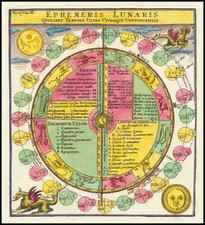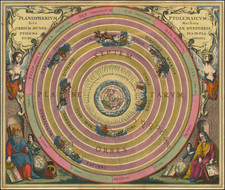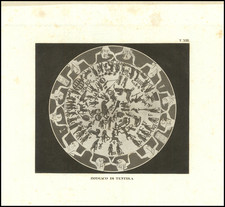Fine example of Cellarius's chart illustrating the Theory of Epicycles, which supported Claudius Ptolemy's earth-centered model of the universe, from the Valk & Schenk edition of Andreas Cellarius' Harmonia Macrocosmica.
In this chart Cellarius demonstrates the Ptolemaic theory of epicycles. The epicycles theory addressed a problem that arose from the assumption that if the earth was the center of the universe, then the circuit of the planets should be of a steady one-directional, circular progress. Observation showed, however, that the orbital progress of the planets was in fact irregular and from these observations arose the ancient theory of epicycles illustrated here.
Andreas Cellarius was born in 1596 in Neuhausen and educated in Heidelberg. He emigrated to Holland in the early 17th century and in 1637 moved to Hoorn, where he became the rector of the Latin School. Cellarius' best known work is his Harmonia Macrocosmica, first issued in 1660 by Jan Jansson, as a supplement to Jansson's Atlas Novus. The work consists of a series of Celestial Charts begun by Cellarius in 1647 and intended as part of a two volume treatise on cosmography, which was never issued.
Cellarius' charts are the most sought after of celestial charts, blending the striking imagery of the golden age of Dutch Cartography with contemporary scientific knowledge.
Andreas Cellarius was born in 1596 in Neuhausen and educated in Heidelberg. He emigrated to Holland in the early 17th century, and in 1637 moved to Hoorn, where he became the rector of the Latin School. Cellarius' best-known work is his Harmonia Macrocosmica, first issued in 1660 by Jan Jansson, as a supplement to Jansson's Atlas Novus. The work consists of a series of Celestial Charts begun by Cellarius in 1647 and intended as part of a two-volume treatise on cosmography, which was never issued.










![A Circle of Winds consisting of 32 points commonly called the Mariners Compass [and] The Artifical Sphere](https://storage.googleapis.com/raremaps/img/small/80340.jpg)

![[ Phases of the Moon ] Phasis Lunae Gibberosae Crescentis, observata Solnoci Anno MDCXCVI die 9 Augusti hor. 10 pomer. [and] Phasis Lunae Adulta, observata Segedini Anno MDCXCVI. Die 11 Iulii, intra hor 10 et 11. pom](https://storage.googleapis.com/raremaps/img/small/95540.jpg)

![[Aquarius]](https://storage.googleapis.com/raremaps/img/small/79552.jpg)
